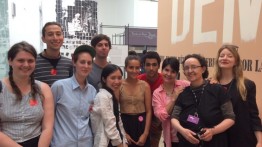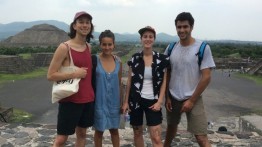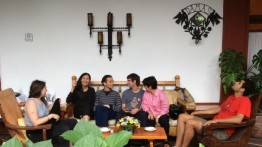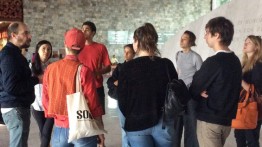Cooper Students Explore Art World of Mexico City
POSTED ON: September 1, 2016
This past June seven students from the School of Art traveled to Mexico City to be part of a 10-day program designed specifically for them. The program was the first collaboration between The Cooper Union and SOMA, an organization founded to introduce young artists, curators and historians from around the world to the contemporary Mexican art world. The artist Carla Herrera-Prats, coordinator of SOMA Summer—an 8-week course that started in 2010—said that the former Dean of the School of Art, Saskia Bos, conceived of the shorter program for Cooper students. “During these ten days, we tried to combine the different aspects that form the base of SOMA’s offerings: seminars and lectures focused on specific topics, visits to local artists’ studios, individual and group critiques, as well as a series of visits to several locations that would be otherwise inaccessible to people who visit the city on their own,” said Ms. Herrera-Prats, who has taught Contemporary Art Issues as an adjunct at Cooper.
Of the seven students who participated, six were 2016 graduates or just one semester shy of graduation and the seventh was a rising junior, Paolo Mentasti who lives in Mexico City. They spent time visiting studios, galleries and museums, and learning about the city. “The invitation was for students to absorb as much as they could in order to be able to produce something in the future, as well as to help them to critically look at their practices from a different perspective,” Ms. Herrera-Prats said. "We call it a program and not a residency because the idea is not to force a result. We focus on the experience.”
When Minh Bui, a Los Angeles native, received an email about the SOMA program, she had just finished reading Roberto Bolaño’s The Savage Detectives, much of which takes place in Mexico City. Her interest in the book as well as in a Mexico City art space called Lulu prompted her to apply. She sent her portfolio and a piece of writing explaining why she was interested. “I wrote about challenging the notion of ‘Mexico’ and ‘Mexico City,’” she said. As an Angeleno, she pointed out, Mexico is ever-present, or more precisely a particular image of Mexico. “I had limited knowledge of the country, but I knew it had been extremely essentialized.”
She found that the 10-day program was unsettling but in the best ways. While she and her classmates were in what she called the “inevitable bubble” of tourism, the program gave them access to artists and artisans working in a wide range of media, including neon sign makers. During SOMA, Bui had individual studio critiques with an artist, a theorist and a curator. They posed challenging questions that made her re-examine her photography. “There was a lot to absorb. Everyone was grabbed by something. For me to go and engage in the spaces and to discover their texture was really amazing ultimately.” She spent six additional days with a few others from the program.
Ruthie Natanzon A'16 found that the SOMA program gave her much to think about regarding her interest in the relationship between art and activism. She has been drawn to the art of cantastoria, an ancient form of storytelling that uses music and large banners or posters as illustrations, and is very much a living art in Mexico. Ms. Natanzon described the trip as a moving experience, both for the art and the more social aspects of the trip. One night, the group went to see Lucha Libre, highly theatrical wrestling battles with raucous audience participation. “It was all so unfamiliar, but it made sense to us. People were ready to believe in the artifice and be completely engaged.”
Both Ms. Bui and Ms. Natanzon reported that it was too soon to know the impact of the program upon their art, but both want to return to Mexico as soon as possible to continue exploring an art scene they found inspiring. “Ideally, it should be important that artists not rush their processes in order to resolve projects,” said Ms. Herrera-Prats. “Our goal is to help students understand what they need and find it, as well as to help them create bonds and connections that will last beyond the ten days in Mexico.”








